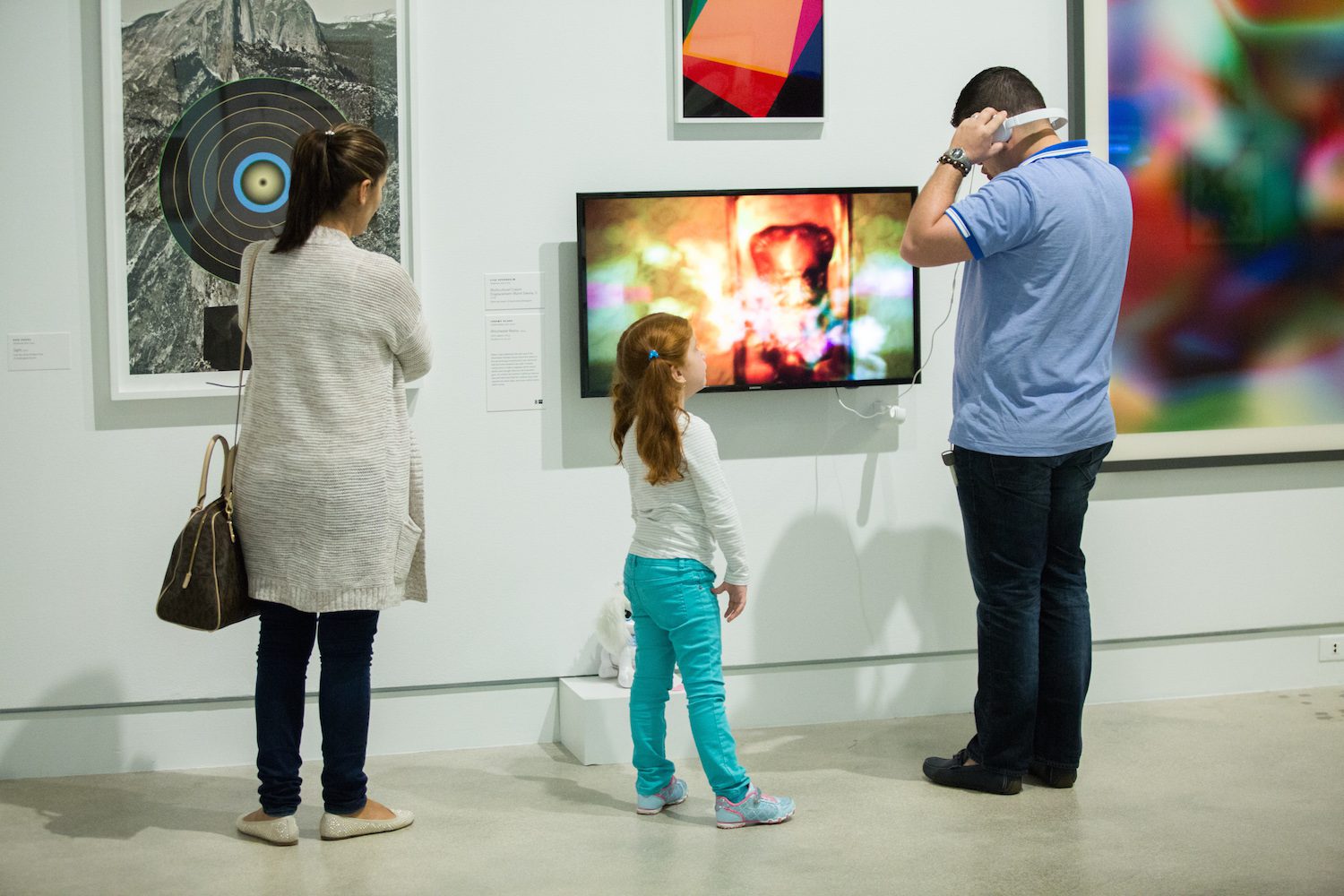 “Still/Moving,” the second part of the Norton Museum’s two-pronged exhibition of the collection of local arts patron Beth DeWoody, is less whimsical than last year’s predecessor, “The Triumph of Love,” which focused on contemporary art and sculpture. But it’s arguably more impactful.
“Still/Moving,” the second part of the Norton Museum’s two-pronged exhibition of the collection of local arts patron Beth DeWoody, is less whimsical than last year’s predecessor, “The Triumph of Love,” which focused on contemporary art and sculpture. But it’s arguably more impactful.
Like any great exhibit of a personal collection, “Still/Moving”—which derives its name from its two mediums, photography and video—is both random and controlled. Rather than surveying a century of art or offering a meditation on the zeitgeist, “Still/Moving” derives its meaning from the collector’s personality and politics, as they are shaped and defined by the decisions of Norton curator Tim Wride and curatorial assistant Rachel Gustafson.
Certainly, Wride had an enormous trove of material from this generous and eclectic collector, culling 200 pieces from an estimated 3,000-plus photographs and videos—from Robert Capa to Cindy Sherman, Diane Arbus to Cecil Beaton, Robert Mapplethrope to Bernd and Hilla Becher. The result is selection of works that, as the curator’s statement expresses, “take risks and also demand a bit of risk from the viewer.”
This statement applies most prominently to DeWoody’s affinity for provocative nudes, like Nobuyoshi Araki’s untitled Polaroid of a naked woman bound in a dark room, leaving the morbid backstory to our imagination. DeWoody is drawn to works in which the human body, at its most elemental, is as mysterious as an abstract painting and as fungible as putty—from Andre Kertesz’s classic fun-house distortions of the human form to Mapplethorpe’s modernist vision of the male profile and Mason Rader’s “Be Good!,” which merges three bodies into a pretzel and carries with it a feminist subtext.
Indeed, Wride’s theme-driven journey through DeWoody’s collection reveals a collector unafraid to engage spectators on issues of race, gender and sexuality, clustered among more benign—but no less compelling—areas of interest such as architecture, fashion and celebrity. There are works that directly confront homelessness, prostitution, gun violence and third-world poverty, finding visual poetry amid the squalor. Such juxtapositions are central to the works’ success: Nathaniel Mary Quinn’s video “Simply Beautiful” artfully counterbalances sounds from battlefield carnage atop images of disadvantaged African-American youth, and lays jaunty cartoon theme music over shots of vacant inner-city buildings. It’s a potent statement of rage from the front lines of Black Lives Matter.

Not that middle-class comforts are any consolation. Skepticism over the supposed pleasures of the American dream manifests in Gregory Crewdson’s untitled high-def print of a bus driver beckoning a child from a sidewalk outside her home at night, a work of ambivalence that, to my eyes, implies menace lurking underneath the manicured lawns of suburbia. James Casebere’s “Subdivision With Spotlight” is a photograph of the artist’s miniature model of a planned community, with its soul-crushing assemblage of uniform Stepford homes. And Jen O’Malley’s “The Attic” is another creepy Polaroid, an image of a shadowy stairwell that will look ominous to anyone who’s seen her share of horror films.
 Most of these artists’ names might not be familiar to most viewers, and their discovery is one of the excitements of “Still/Moving.” Even works chosen by established artists are generally less iconic and therefore fresh; the Chuck Close photo in the show is not an extreme close-up of a face but of a sunflower. The Andy Warhol sextet of identical, color-tinted images is not of Mao but the Red Hot Chili Peppers, shot in the twilight of the artist’s career. “Still/Moving” engages even the familiar in new contexts, thereby forming novel relationships to the work around it.
Most of these artists’ names might not be familiar to most viewers, and their discovery is one of the excitements of “Still/Moving.” Even works chosen by established artists are generally less iconic and therefore fresh; the Chuck Close photo in the show is not an extreme close-up of a face but of a sunflower. The Andy Warhol sextet of identical, color-tinted images is not of Mao but the Red Hot Chili Peppers, shot in the twilight of the artist’s career. “Still/Moving” engages even the familiar in new contexts, thereby forming novel relationships to the work around it.
 As a cinephile, though, I was most drawn to the videos in the exhibition, particularly the experimental collages that repurpose, and redefine, clips from film history. Johan Grimonprez’s brooding agitprop “Doubletake” finds a correlative in the films and persona of Alfred Hitchcock, who creatively peaked in the 1960s, with the Cold War panic of the era and its doom-laden bluster about a nuclear winter. Phoebe Collings-James’ mesmerizing mash-up “The Descent” is a work of giddy film-history deconstructionism, with nine miniature screens simultaneously projecting images of characters descending steps forward and backward, drawing parallels between “The Battleship Potemkin,” “The Untouchables,” the animated “Cinderella,” “The Exorcist,” “Paranormal Activity,” “American Psycho” and more.
As a cinephile, though, I was most drawn to the videos in the exhibition, particularly the experimental collages that repurpose, and redefine, clips from film history. Johan Grimonprez’s brooding agitprop “Doubletake” finds a correlative in the films and persona of Alfred Hitchcock, who creatively peaked in the 1960s, with the Cold War panic of the era and its doom-laden bluster about a nuclear winter. Phoebe Collings-James’ mesmerizing mash-up “The Descent” is a work of giddy film-history deconstructionism, with nine miniature screens simultaneously projecting images of characters descending steps forward and backward, drawing parallels between “The Battleship Potemkin,” “The Untouchables,” the animated “Cinderella,” “The Exorcist,” “Paranormal Activity,” “American Psycho” and more.
But if the sign of a great collector is her ability—unconscious, perhaps—to select art that will not only stand the test of time but presciently forecast it, then it doesn’t get better than Nelson Hallonquist’s “Gesticulations of an American Icon.” The artist cherry-picked guttural sound effects from vintage Bill Cosby comedy routines, stripped them of context, and glued them together in an incoherent montage of lunatic gibberish. In 2008, when Hallonquist exhibited the work, it must have been seen as a hilarious re-appropriation of an artist’s craft. Now, knowing what we do about Cosby’s extramarital activities, it’s astonishing how much of the comedian’s human beatboxing sounds aggressive, territorial and downright predatory.
Bravo to DeWoody for what is at least a happy accident of discovery, if not a prophetic purchase—and to Wride for including it in this naked, voluminous peak into a collector’s psyche.
“Still/Moving” runs through May 15 at the Norton Museum of Art, 1451 S. Olive Ave., West Palm Beach. Admission costs $5 students and $12 adults. Call 561/832-5196 or visit norton.org.







